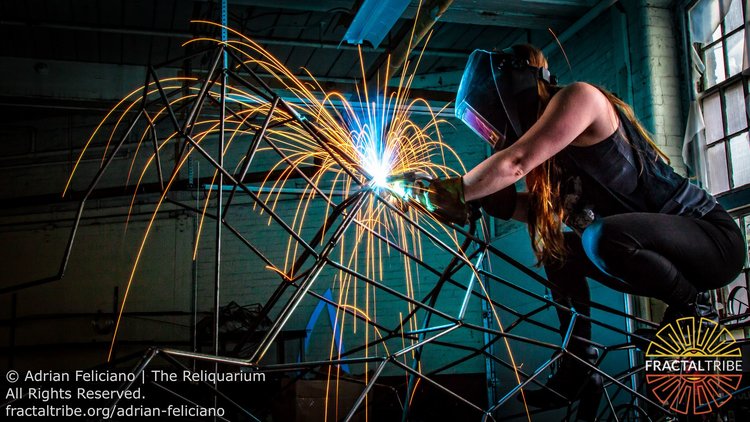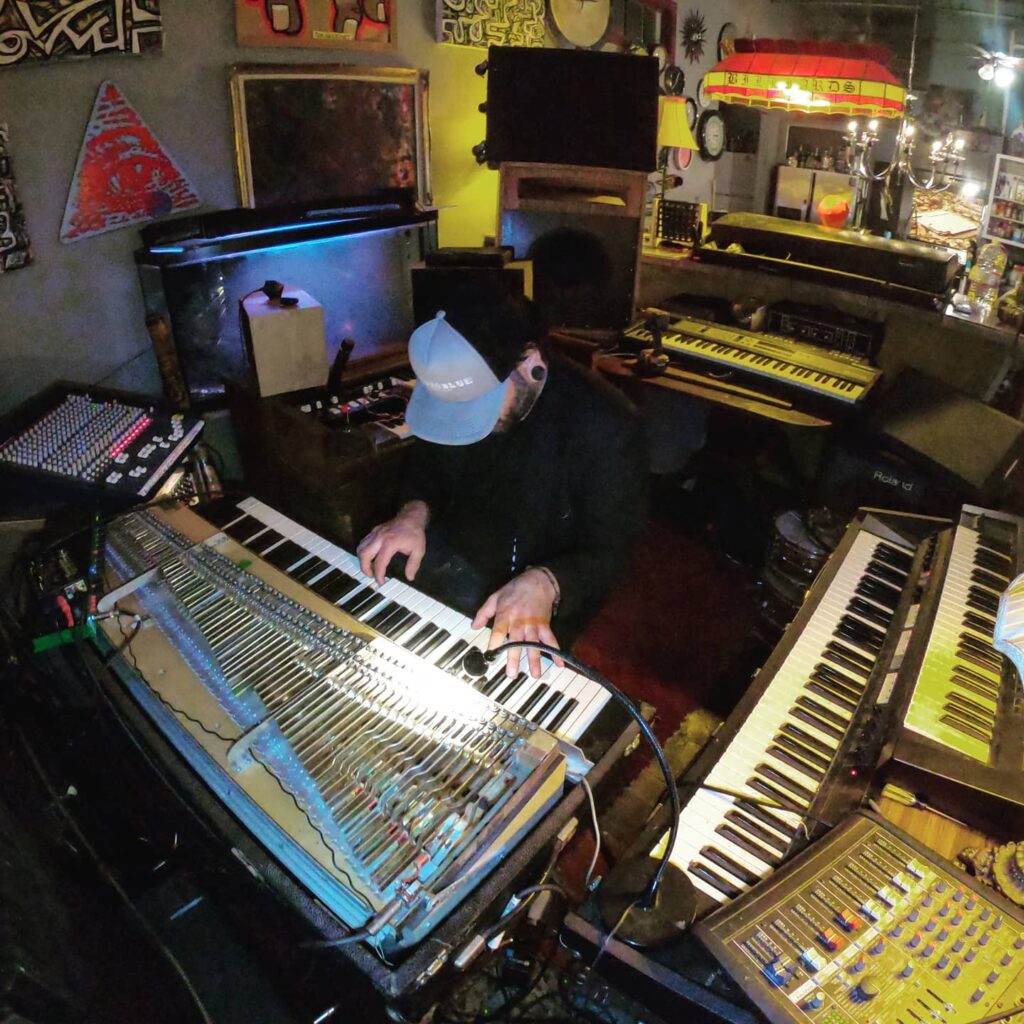“The pandemic reminded us how important it is to be near each other as humans,” says Logan Will, who co-founded The Reliquarium in Lincoln with his partner, Ivy Ross. For artist collectives like The Reliquarium, community has always been a core principle. Creativity and community go hand in hand, and a collective can give individual artists the supportive environment they need to realize their artistic dreams. “The only way I’ve found to get the mental freedom to create a thing is to work together,” says Rick Scianablo, founder of Studio Blue in Providence.

Photo of Ivy Ross by Adrian Feliciano and is used with permission.
This past year has spurred reflection and adaptation for many artists and artist collectives. It’s no secret that artists, already underpaid for their work, have been hard hit by the pandemic. As the economy crashed, people spent less money on art. Many artists found relief from grant programs like RISCA’s Artist Relief Fund. “I was filling out grant proposals for artist assistance for 15 people in my office, one at a time,” says Scianablo.
Every artist I talked to expressed gratitude for their existing communities, which helped them survive the year. “Everyone was stuck,” says Scianablo. “We were lucky because we were stuck with each other.”
Ross concurs: “We were all quarantining together. We were able to hunker down and get into all these ideas.” For The Reliquarium, which traditionally generated income through large-scale set builds for concerts and events, the lockdown meant a complete shift in artistic focus. “We were in Costa Rica finishing up a massive stage made of bamboo,” says Will. “We got on a plane to come home and the borders closed.”
Luckily, Ross, Will and their cohort already had a monumental project on their hands: an immersive 25-room gaming facility for R1 Indoor Karting in Lincoln called TimeZone. TimeZone “really took over The Reliquarium,” says Will. “We were able to pull a lot of people in, I think 30 to 45 of our friends and other specialists, to really sink our teeth into this project all throughout the pandemic. We were very fortunate to be right in the middle of something that was local, and also this great opportunity to flex our creative muscles.”
The pandemic almost spelled financial ruin for Studio Blue, which houses 20 artists in their Summer Street space. “We were a few days away from opening up a new venue called The Fifth Dimension when coronavirus hit,” explains Scianablo. A series of frustrating accidents prevented Scianablo from signing the lease in time, inadvertently saving the organization. “We would’ve been on a five-year lease for $5,000 a month and we would’ve been dead,” he mused. “You realize the universe takes over a little.”
In spite of the difficulties this year has presented for collaboration, artists throughout the state have found different ways to create together. Jonesy Mann, director of the Live/Work program at AS220, described some of the work done by AS220 resident artists this past year. “Early in the pandemic, a bunch of people came together to make PPE. We had residents making face shields, residents sewing masks. In the summer, when the reckoning with racial justice was happening across the country and in Providence, we activated our print shop, and a lot of our residents made signs that were seen throughout the city in support of Black Lives Matter. That was a way that our community came together.”

AS220’s Live/Work program rents out 47 residential artist studios. “Our mission is to nurture and create a forum for the arts in Rhode Island,” says Mann. “It’s really important for artists to have affordable places to live in this state, which is a really challenging thing with housing prices going up. The Live/Work Program is a way to address that.”
For Ross and Will, the hunt for space is what brought The Reliquarium to Rhode Island in the first place. “Logan and I met at school in Boston,” explains Ross. “We ended up moving to Rhode Island as a way to house more people and to be able to create art.” The Reliquarium started with a single space and six artists and has grown to encompass three spaces: Relic Works, their business, Relic Studios, a cooperative work space, and Relic Ranch, a small, sustainable farm.
The Reliquarium is a 24-hour operation, says Will: “The circadian rhythm for every artist is different. At any given time in the studio there are people working: welding, ceramics, casting, printing, we’ve got a music dungeon, glass blowing, painting, digital media production, culinary arts — it feels like an ant farm sometimes the way people have come in and added their specialized skill sets. There’s this constant flowing of opportunities to collaborate with each other in ways nobody would have initially expected.”
Every organization I spoke with defined “art” broadly. “We take a non-exclusive approach to that term,” says Mann. In evaluating Live/Work Applications, he says, AS220 considers “anybody who applies their creativity toward a passion of theirs in their life” to be an artist. That capacious definition allows the collectives and communities I spoke with to become as diverse and vibrant as possible.
Scianablo takes a similar approach. An artist, he told me, is “someone who’s trying to push the boundary of what reality is.” While Studio Blue welcomes many artists working in traditional media like painting, sculpture and music, they also work with artists using their creativity to do more than just entertain. “One of the guys we’re working with is developing a case that’s designed to keep organs colder for longer when they’re being transported,” he told me, and Scianablo himself has experimented with using sound frequencies for medical purposes.
Building an artist collective, for Scianablo, means “providing the freedom to have your environment the way you want.” Creating that freedom comes with challenges. “Twenty artists living in 10,000 square feet maybe seems crazy, but it’s crazier than it seems.”
Last month Studio Blue made a million dollar offer for the building they occupy, but lost it to a developer. “Our fate has always been on the edge of existence and annihilation,” says Scianablo. “We have to be comfortable there because that’s the only place we can be. It doesn’t seem like we’re destined to be comfortable and that’s okay, because it makes for good art and music. That’s where your energy comes from.”
In spite of this precariousness, Scianablo and his fellow artists continue to explore new vistas. I met Scianablo at The VR Zone at the Providence Place Mall. This new virtual reality gaming facility features walls chock-full of art by Studio Blue residents among a number of immersive video games. Scianablo seemed excited about the creative possibilities of virtual reality. “You’re in a virtual reality lab giving an interview about community spaces — this is the future of it.”
All of the artists I spoke with were enthusiastic about the future of creative collaboration in the state, and the new opportunities that are beginning to emerge. “We do need each other to survive as artists,” says Ross. “I’m excited to continue to grow as a community.” Logan compared the momentum of their cooperative to a dung beetle’s ball — growing as it moves forward. “It’s sacred,” he says. “Every day is a beautiful ball of shit.”


